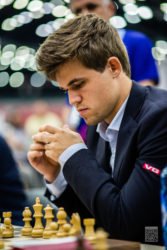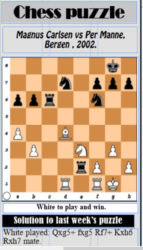Norway’s chess grandmaster Magnus Carlsen turned 26 on Wednesday, and captured chess’ biggest prize, the world championship title on his birthday. Carlsen has now won the title thrice, since taking it from the Indian grandmaster Viswanathan Anand in 2013. The championship match with the Russian challenger Sergey Karjakin proceeded into the overtime rapid-game play, following a  rigorous draw in the robust 12-game series of traditional chess. In the rapids, Carlsen won twice in four games to secure the important title which we fondly refer to as “the holy grail of chess.” With the exception of the twelfth game, the classical match was ravishing and compelling. The world champion, who had grown accustomed to having things his way, was severely stretched by his worthwhile opponent. Karjakin struck first in the eighth game, after seven scintillating draws. The victory came as a surprise to Carlsen’s world-wide fans, and, perhaps, to Carlsen himself. But following that ignominious stumble, Carlsen picked himself up and retaliated to take the tenth game. Fans sensed when it mattered, the champ can go straight to the heart of the matter, and succeed. The 11th game was a fighting one in which the contenders played the popular Ruy Lopez, the most tested game of the championship. Playing the black pieces, Carlsen created an energetic passed pawn through a pawn sacrifice, and was going all out for the win. It was not to be, because the champ’s king was exposed and his opponent had the ultimate drawing weapon, perpetual check. This brought us to the 12th and final game of classic chess under standard time controls, last Monday. The New York Times reported that the 12th game was the shortest in world championship history.
rigorous draw in the robust 12-game series of traditional chess. In the rapids, Carlsen won twice in four games to secure the important title which we fondly refer to as “the holy grail of chess.” With the exception of the twelfth game, the classical match was ravishing and compelling. The world champion, who had grown accustomed to having things his way, was severely stretched by his worthwhile opponent. Karjakin struck first in the eighth game, after seven scintillating draws. The victory came as a surprise to Carlsen’s world-wide fans, and, perhaps, to Carlsen himself. But following that ignominious stumble, Carlsen picked himself up and retaliated to take the tenth game. Fans sensed when it mattered, the champ can go straight to the heart of the matter, and succeed. The 11th game was a fighting one in which the contenders played the popular Ruy Lopez, the most tested game of the championship. Playing the black pieces, Carlsen created an energetic passed pawn through a pawn sacrifice, and was going all out for the win. It was not to be, because the champ’s king was exposed and his opponent had the ultimate drawing weapon, perpetual check. This brought us to the 12th and final game of classic chess under standard time controls, last Monday. The New York Times reported that the 12th game was the shortest in world championship history.
Monday was lamentable. The contenders of the world chess championship match played to a colourless draw in the final game of their traditional classical encounter. Perhaps it was Carlsen who signalled his intention of going for the draw by playing one of the most solid variations against the Berlin Defence of the Ruy Lopez. By move 30, after 36 minutes, and with all the major pieces exchanged, the morally offensive draw was reached. There was no fight to the end as in the 24th and final game of the 1985 Karpov-Kasparov world championship match. Kasparov was forced to play for a win, and win he did. A draw would have meant Karpov would keep the world championship title.
Perhaps it was the caprice of Carlsen and Karjakin to engineer an academic draw in this instance, making way for the unpredictable rapid and blitz phases of the match. Carlsen was ranked No 1 in rapid chess, and No 2 in the blitz format of the game. Karjakin claimed the No 11 spot in blitz chess. However, prior to the change-over to the rapids and blitz, Carlsen was reported to have said each player possessed a 50-50 chance to win the match.

Based on his No 1 rank in rapid chess, Carlsen was better mentally equipped to successfully tackle the four rapid games which he had to contest. In the first rapid game, another solid Ruy Lopez, neither player gave up an inch of territory. Peace was realized, and the inevitable draw was called. In the second game, this time an Italian opening and not the common Ruy Lopez, Karjakin emerged from a series of exchanges with a rook and a pawn against two bishops. By move 40, Karjakin had 59 seconds remaining on his clock while Carlsen had just under four minutes. Carlsen possessed an extra h-pawn but could not make any headway after his opponent got his king into a formidable position on a black square, and sacrificed his advantageous rook for Carlsen’s black bishop. Draw.
In game three, Karjakin, who had held on for almost all of the championship, finally blundered in serious time trouble. Carlsen perceived the win he required. The Russian grandmaster resigned the game. Score: 2-1 in favour of Carlsen. Going into the final fourth round game, the champ enjoyed a huge psychological advantage from which his opponent never recovered. Playing the white pieces in the fourth, Carlsen knew Karjakin had to take risks in order to stay in the match. Karjakin played the tantalizing Sicilian defence which brings complications and gives Black a fighting chance to win. It was not to be. Carlsen finished the match with a crashing queen sacrifice 50. Qh6+!! . Magnus Carlsen had retained his world championship chess title.
Chess game
The games listed hereunder were played at the 2016 World Chess Championship in New York. Magnus Carlsen retained his world championship title.
Game 10
White: Magnus Carlsen
Black: Sergey Karjakin
1.e4 e5 2.Nf3 Nc6 3.Bb5 Nf6 4.d3 Bc5 5.c3 O-O 6.Bg5 h6 7.Bh4 Be7 8.O-O d6 9.Nbd2 Nh5 10.Bxe7 Qxe7 11.Nc4 Nf4 12.Ne3 Qf6 13.g3 Nh3+ 14.Kh1 Ne7 15.Bc4 c6 16.Bb3 Ng6 17.Qe2 a5 18.a4 Be6 19.Bxe6 fxe6 20.Nd2 d5 21.Qh5 Ng5 22.h4 Nf3 23.Nxf3 Qxf3+ 24.Qxf3 Rxf3 25.Kg2 Rf7 26.Rfe1 h5 27.Nf1 Kf8 28.Nd2 Ke7 29.Re2 Kd6 30.Nf3 Raf8 31.Ng5 Re7 32.Rae1 Rfe8 33.Nf3 Nh8 34.d4 exd4 35.Nxd4 g6 36.Re3 Nf7 37.e5+ Kd7 38.Rf3 Nh6 39.Rf6 Rg7 40.b4 axb4 41.cxb4 Ng8 42.Rf3 Nh6 43.a5 Nf5 44.Nb3 Kc7 45.Nc5 Kb8 46.Rb1 Ka7 47.Rd3 Rc7 48.Ra3 Nd4 49.Rd1 Nf5 50.Kh3 Nh6 51.f3 Rf7 52.Rd4 Nf5 53.Rd2 Rh7 54.Rb3 Ree7 55.Rdd3 Rh8 56.Rb1 Rhh7 57.b5 cxb5 58.Rxb5 d4 59.Rb6 Rc7 60.Nxe6 Rc3 61.Nf4 Rhc7 62.Nd5 Rxd3 63.Nxc7 Kb8 64.Nb5 Kc8 65.Rxg6 Rxf3 66.Kg2 Rb3 67.Nd6+ Nxd6 68.Rxd6 Re3 69.e6 Kc7 70.Rxd4 Rxe6 71.Rd5 Rh6 72.Kf3 Kb8 73.Kf4 Ka7 74.Kg5 Rh8 75.Kf6 1-0.
Game 12
White: Magnus Carlsen
Black: Sergey Karjakin
1.e4 e5 2.Nf3 Nc6 3.Bb5 Nf6 4.O-O Nxe4 5.Re1 Nd6 6.Nxe5 Be7 7.Bf1 Nxe5 8.Rxe5 O-O 9.d4 Bf6 10.Re1 Re8 11.Bf4 Rxe1 12.Qxe1 Ne8 13.c3 d5 14.Bd3 g6 15.Na3 c6 16.Nc2 Ng7 17.Qd2 Bf5 18.Bxf5 Nxf5 19.Ne3 Nxe3 20.Qxe3 Qe7 21.Qxe7 Bxe7 22.Re1 Bf8 23.Kf1 f6 24.g4 Kf7 25.h3 Re8 26.Rxe8 Kxe8 27.Ke2 Kd7 28.Kd3 Ke6 29.a4 a6 30.f3 Be7 1/2-1/2.
White: Sergey Karjakin
Black: Magnus Carlsen
1.e4 e5 2.Nf3 Nc6 3.Bb5 a6 4.Ba4 Nf6 5.O-O Be7 6.d3 b5 7.Bb3 d6 8.a3 O-O 9.Nc3 Na5 10.Ba2 Be6 11.b4 Nc6 12.Nd5 Nd4 13.Ng5 Bxd5 14.exd5 Nd7 15.Ne4 f5 16.Nd2 f4 17.c3 Nf5 18.Ne4 Qe8 19.Bb3 Qg6 20.f3 Bh4 21.a4 Nf6 22.Qe2 a5 23.axb5 axb4 24.Bd2 bxc3 25.Bxc3 Ne3 26.Rfc1 Rxa1 27.Rxa1 Qe8 28.Bc4 Kh8 29.Nxf6 Bxf6 30.Ra3 e4 31.dxe4 Bxc3 32.Rxc3 Qe5 33.Rc1 Ra8 34.h3 h6 35.Kh2 Qd4 36.Qe1 Qb2 37.Bf1 Ra2 38.Rxc7 Ra1 0-1.
White: Magnus Carlsen
Black: Sergey Karjakin
1.e4 c5 2.Nf3 d6 3.d4 cxd4 4.Nxd4 Nf6 5.f3 e5 6.Nb3 Be7 7.c4 a5 8.Be3 a4 9.Nc1 O-O 10.Nc3 Qa5 11.Qd2 Na6 12.Be2 Nc5 13.O-O Bd7 14.Rb1 Rfc8 15.b4 axb3 16.axb3 Qd8 17.Nd3 Ne6 18.Nb4 Bc6 19.Rfd1 h5 20.Bf1 h4 21.Qf2 Nd7 22.g3 Ra3 23.Bh3 Rca8 24.Nc2 R3a6 25.Nb4 Ra5 26.Nc2 b6 27.Rd2 Qc7 28.Rbd1 Bf8 29.gxh4 Nf4 30.Bxf4 exf4 31.Bxd7 Qxd7 32.Nb4 Ra3 33.Nxc6 Qxc6 34.Nb5 Rxb3 35.Nd4 Qxc4 36.Nxb3 Qxb3 37.Qe2 Be7 38.Kg2 Qe6 39.h5 Ra3 40.Rd3 Ra2 41.R3d2 Ra3 42.Rd3 Ra7 43.Rd5 Rc7 44.Qd2 Qf6 45.Rf5 Qh4 46.Rc1 Ra7 47.Qxf4 Ra2+ 48.Kh1 Qf2 49.Rc8+ Kh7 50.Qh6+ 1-0.






